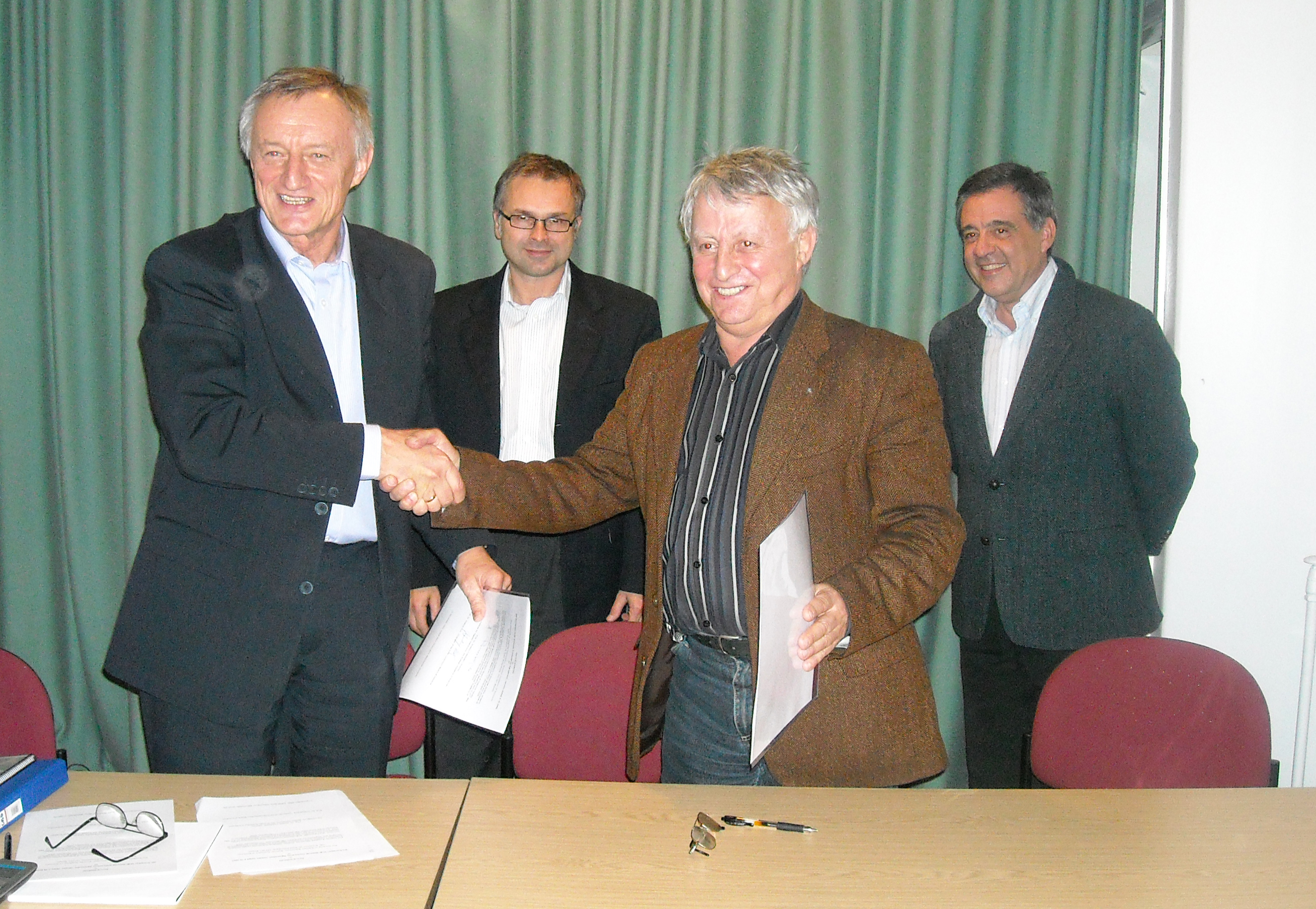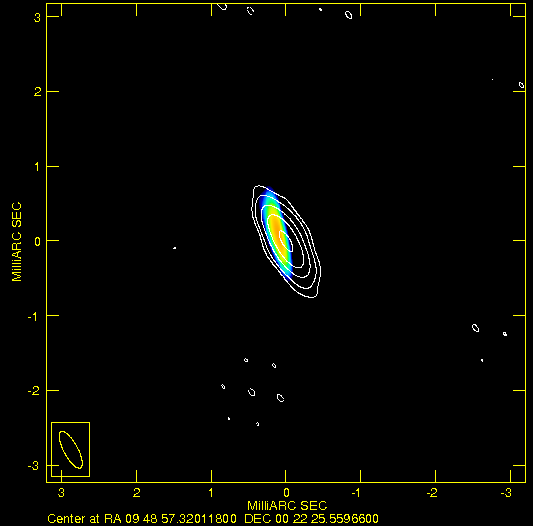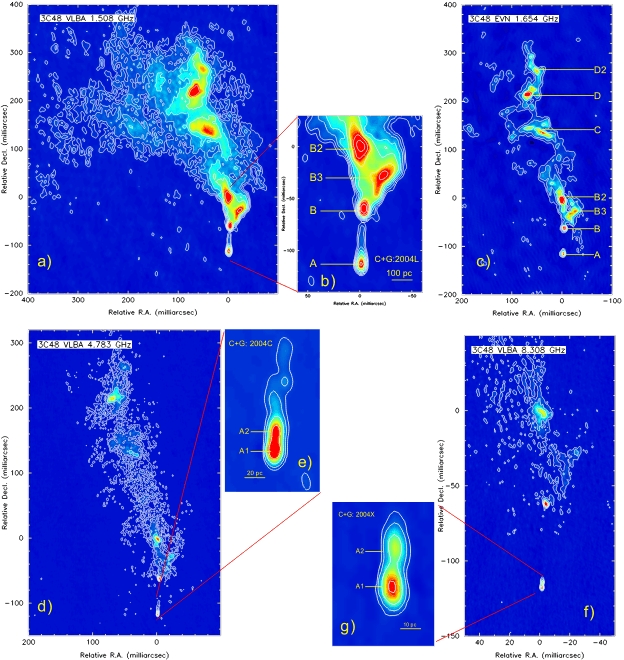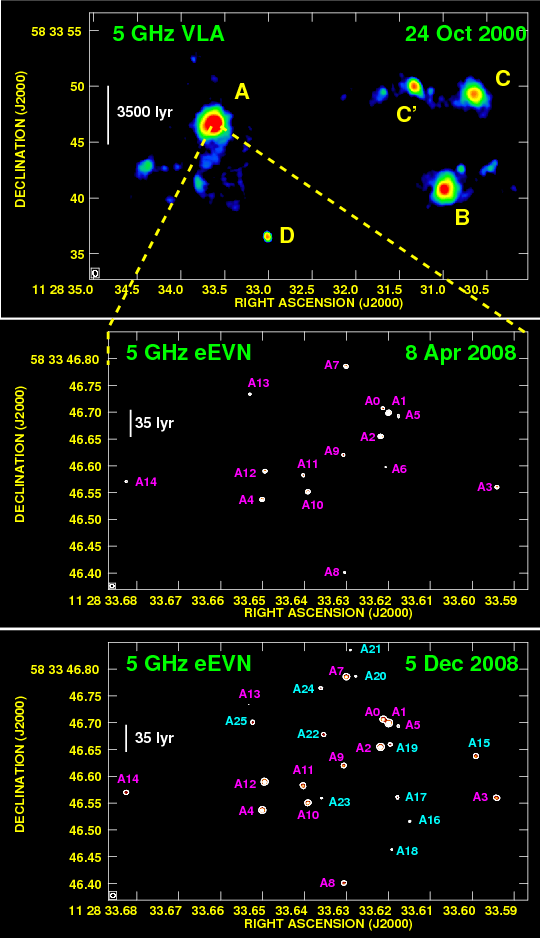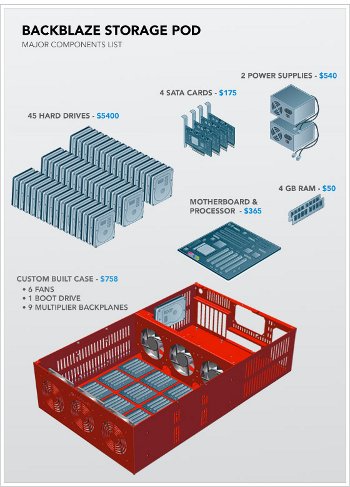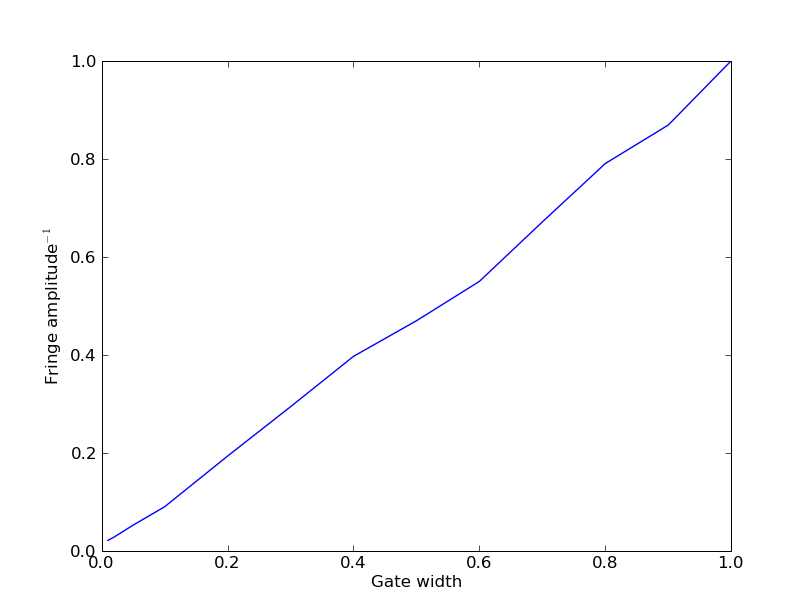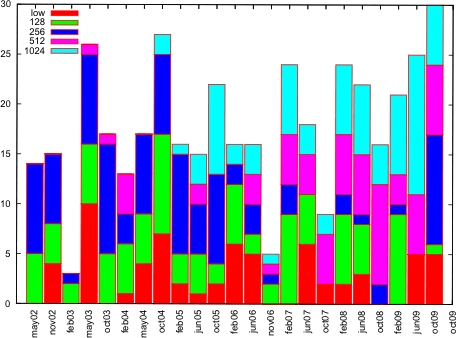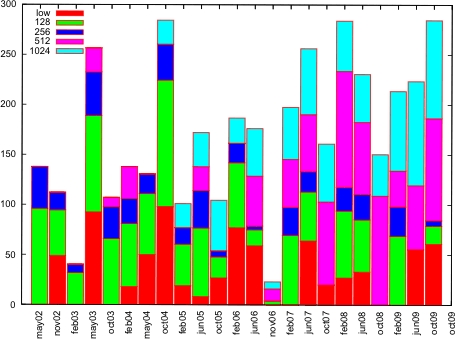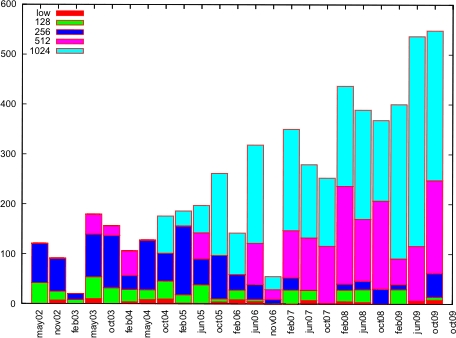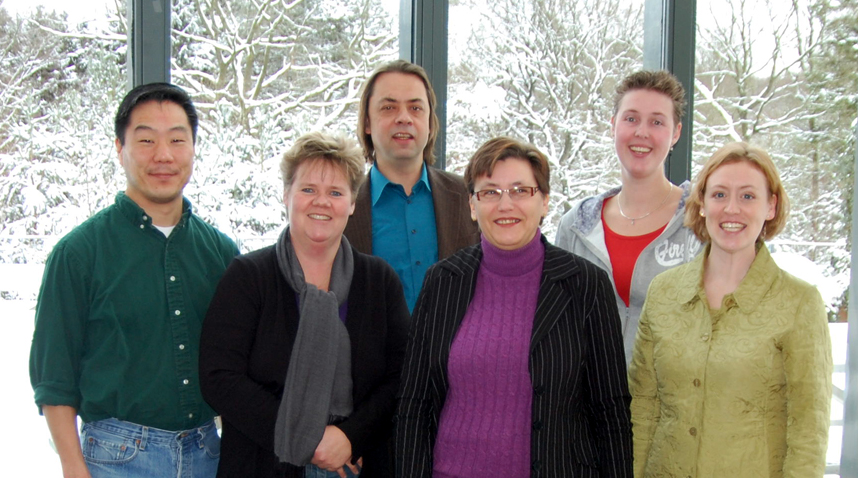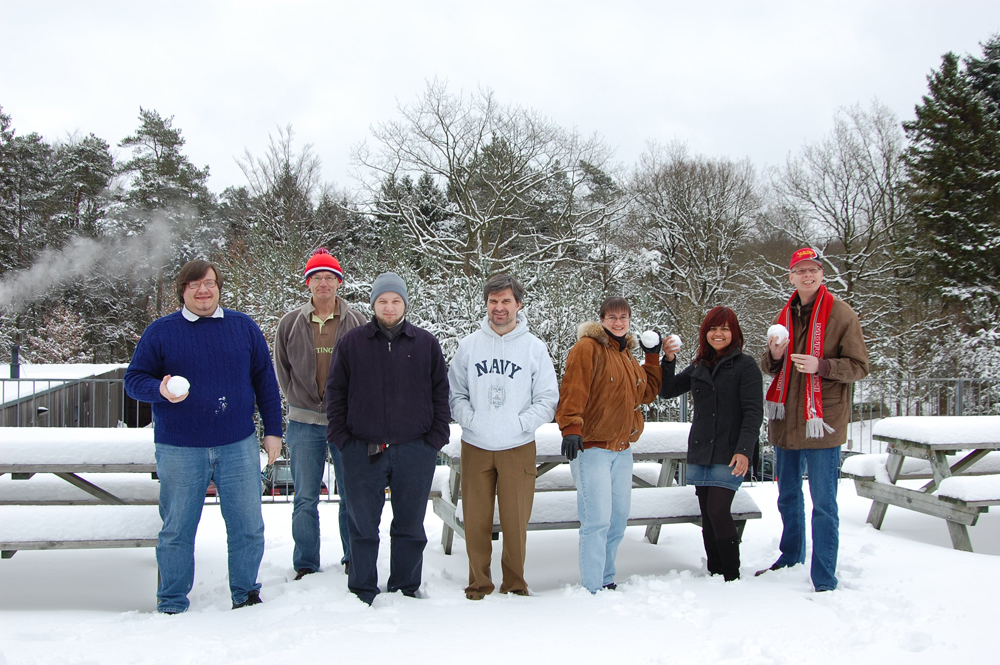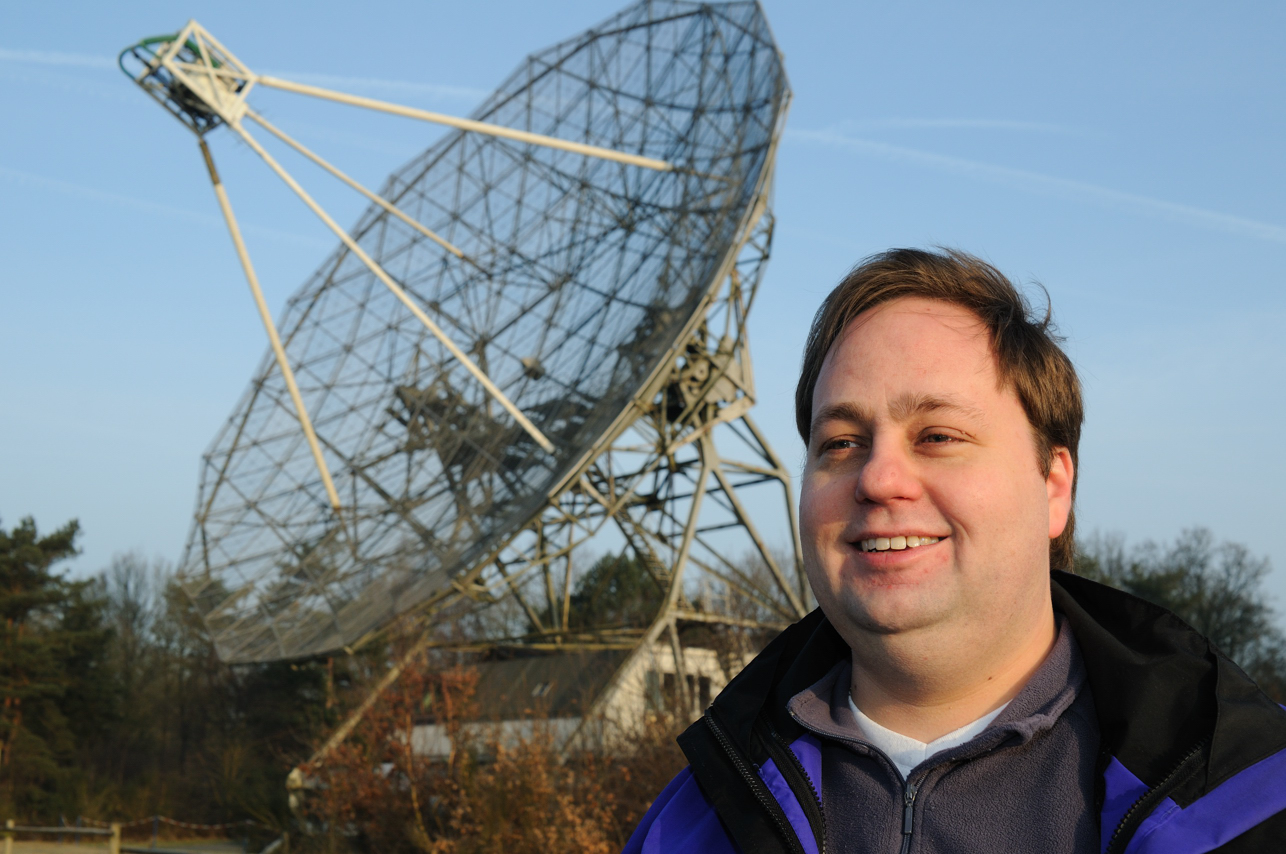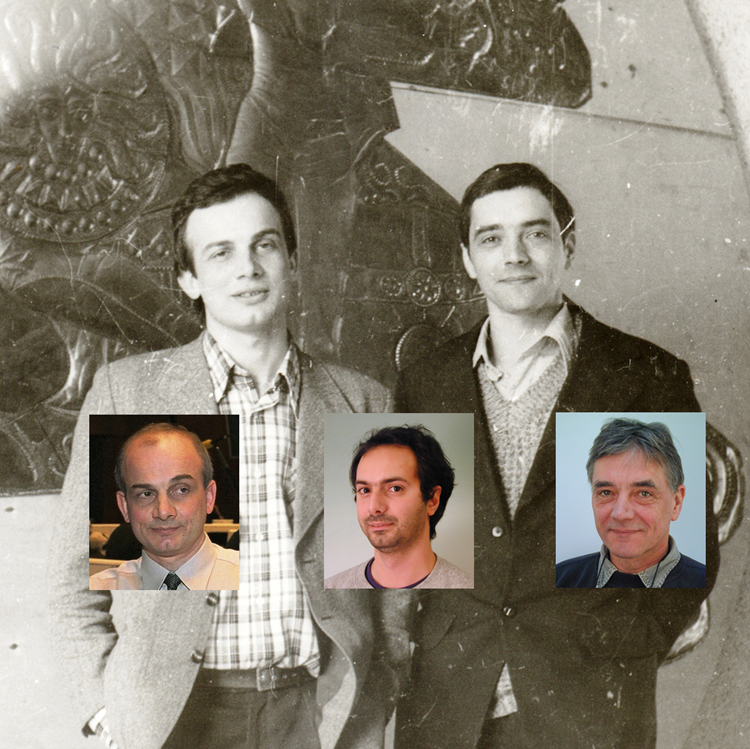|
|
European
VLBI Network Newsletter Number
25 January
2010 |
1. Message
from the EVN Chairman
We (the editor and myself) invite you to read and enjoy the first issue of
2010 letter, and we hope that you will find its content interesting and
useful.
First of all let me draw your attention to the very important, a historic
event - the signing of the EVN access document by Director of the Institute
of Applied Astronomy Russian Academy of Sciences. After long break, Russia
becomes formally partner of the European VLBI Network Consortium. Russia has
long standing history of VLBI activities and currently is also participating
in the geodetic global system the IVS. The new 32m antennas and possibly in
near future 70m telescopes will strengthen the EVN performance. The Russian
KVAZAR Network as part of EVN, fills large gap between European and Chinese
antennas and adds extra collecting area. First real time e-EVN fringes
recently obtained show capability to participate fully in European
development. In coming years the new SRT and possibly Ukrainian 70m and
Latvian 32m will add more power to the EVN.
There is also another aspect of this event. It happened in time of
celebrations commemorating the fall of the cold war wall dividing people of
Europe for 44 years to two opposed political systems. Despite the
oppressive rules of communist governments the scientists from both sides
maintained cooperation and the VLBI was one of such very successful areas.
Yet until very recently the other circumstances, mostly economical and
organizational limitations, less the political once, did not create
sufficient conditions for full unification. The EVN paves the way
towards, unprecedented at this part of the world, large scale highly
efficient cooperation in science, and helps to formulate new concepts of the
future international projects.
Progress in e-EVN operation continues, the activity of JIVE and EVN
Consortium to recognize e-EVN as the SKA path finder may soon result in
important decision which will allow the EVN partners to access a new channel
of European funds. The e-technologies being developed and implemented for
e-EVN are of the unique value for SKA project studies.
Another important area of the EVN progress is directly related to FP7
RadioNet program. The JRA (AMSTAR+, APRICOT, UniBoard, ALBiUS) and the TNA
funds help to continue technological advance and robustness of EVN
telescopes. It provides support (Networking Activities) to improve the
mobility, exchange of knowledge, and better use of human and material
resources. One of the very important aspects of FP7 activities is organizing
and financing international scientific meetings, especially to attract and
support young researchers from European (and not only) countries. We
encourage young scientists and research students to explore the new
challenges.
In the area of EU FP6/7 a special thanks and sincere congratulations go to
Prof. Phillip Diamond, the leader and coordinator of FP6 RadioNet, who
recently was offered a new responsibilities as CSIRO Astronomy and Space
Science Division Director. We all hope to continue our successful
scientific cooperation in FP programs and in VLBI.
I would like to express our special thanks to all who proposed and conducted
a series of successful events as Radio Astronomy part of the IYA 2009
activities. These were outstanding extremely well internationally recognized
science achievements.
Special thanks go to JIVE correlator team for their coordination and hard
work not only to add glory to IYA celebrations but to continuously improve
e-EVN operation quality.
The scientific achievements and highlights presented in this issue of the
News Letter reflect joint activity of EVN Institutes, means many people who
make the EVN one of the best RA instrument in the world. Thanks to all.
We wish you the 2010 to be fruitful and prosperous.
Andrzej Kus, Chairman of the EVN Board of Directors.
2. Call
for EVN Proposals - February 1st 2009
ALL EVN,
GLOBAL, and e-VLBI PROPOSALS must now be submitted
with the
ONLINE
PROPOSAL SUBMISSION tool Northstar.
(This text is also
available on the web at http://www.ira.inaf.it/evn_doc/call.txt)
Observing proposals are
invited for the EVN, a VLBI network of radio telescopes spread throughout
The
observations may be conducted with disk recording (standard EVN) or in real-time
(e-VLBI).
The
EVN is open to all astronomers. Use of the Network by astronomers not
specialized in the VLBI technique is encouraged.
The
Joint Institute for VLBI in Europe (JIVE) can provide support and advice on
project preparation, scheduling, correlation and analysis. See EVN User Support
at http://www.jive.nl.
Standard
EVN Observing Sessions in 2010 (disk recording)
|
2010 Session 2 |
May 27 - Jun 17 |
18/21cm, 6cm, 5cm |
|
2010 Session 3 |
Oct 21 - Nov 11 |
18/21cm, 6cm, ...
|
Proposals received by 1 February 2010 will be considered for scheduling
in Session 2, 2010 or later. Finalisation of the planned observing
wavelengths will depend on proposal pressure.
e-VLBI
Observing Sessions in 2010(real-time)
|
2010 Mar 30 - Mar 31 (start at 13
UTC) 2010 Apr 22 - Apr 23 (start at 13
UTC) 2010 May 18 - May 19 (start at 13
UTC) |
18/21cm, 6cm, 5cm or 1.3cm
18/21cm, 6cm, 5cm or 1.3cm
18/21cm, 6cm, 5cm or 1.3cm
|
Please consult the e-EVN web page at
http://www.evlbi.org/evlbi/e-vlbi_status.html
to check for any updates and for the available array.
Note
that only one wavelength will be run in each session, depending on proposal
priorities.
There
are three e-VLBI observation classes: general e-VLBI proposals; triggered e-VLBI
proposals; short observations. General and triggered e-VLBI proposals must be
submitted by the February 1st deadline to be considered for scheduling in the above
e-VLBI sessions starting from December 2009.
Requests for short
observations (up to two hours) may be submitted up to three weeks prior to any
e-VLBI session.
Continuum and spectral
line observations can be carried out.
See
http://www.ira.inaf.it/evn_doc/guidelines.html for details
concerning the e-VLBI observation classes and the observing
modes.
Features
for the next regular EVN and e-VLBI sessions
1. We are happy to announce that the Institute of Applied Astronomy,
Russian Academy of Sciences, St. Petersburg, joined the EVN in November
2009. The 32m radio telescopes of its KVAZAR network at Svetloe
(Sv), Zelenchukskaya (Zc) and Badary (Bd) will be made available for EVN
observing sessions. Proposers may request these telescopes in EVN
proposals for observations at 18cm, 6cm and 3.6/13cm, beginning
with EVN Session 2, 2010 (see:http://www.ipa.nw.ru/).
2. EVN is now accepting proposals including pulsar gating/binning.
Please consult http://www.ira.inaf.it/evn_doc/guidelines.html
for details.
3. The hardware VLBA correlator has now been replaced by a software
(DiFX) correlator. Processing of all scientific observations in Socorro
uses this correlator. Mk5B playback is now supported
(http://www.ira.inaf.it/evn_doc/guidelines.html).
4. Due to the e-MERLIN construction only an incomplete
MERLIN array will be available in early 2010 due to limited resources. For
updated information please consult the web at http://www.merlin.ac.uk/evn+merlin.html
Note that EVN+MERLIN projects will be considered only for EVN observing
and MERLIN separate observing when eMERLIN will be completed.
5. Please
consult http://www.evlbi.org/evlbi/e-vlbi_status.html
for the current e-VLBI array and for the availability of different
eVLBI stations per observing band and for the dates
of
the e-VLBI observing sessions.
Large
EVN projects
Most
proposals request 12-48hrs observing time. The EVN Program Committee (PC) also
encourages larger projects (>48 hrs); these will be subject to more detailed
scrutiny, and the EVN PC may, in some cases, attach conditions on the release of
the data.
How to
submit
All
EVN, Global and e-VLBI proposals (except ToO
proposals) must be submitted using the on-line proposal
submission tool Northstar. Global proposals will
be forwarded to NRAO automatically and do not need to be submitted to NRAO
separately.
To
use Northstar, people should register (at http://proposal.jive.nl, only for the
first proposal
submission), enter the information about the investigators and the technical
specifications of the proposed observations (equivalent to that previously in
the coversheet) using the on-line forms, and upload a scientific justification
in pdf or ps format. The
scientific justification MUST BE LIMITED to 2 pages in length. Up to 2
additional pages with diagrams may be included. The deadline for submission is
23:59:59 UTC on 1 February 2010.
Additional
information
Further information on
Global VLBI, EVN+MERLIN and e-VLBI observations, and guidelines for proposal
submission are available at:
http://www.ira.inaf.it/evn_doc/guidelines.html
The
EVN User Guide (http://www.evlbi.org/user_guide/user_guide.html) describes
the network and provides general information on its
capabilities.
The
current antenna capabilities can be found in the status tables. For the standard
EVN see http://www.evlbi.org/user_guide/EVNstatus.txt. For the
e-VLBI array see http://www.evlbi.org/evlbi/e-vlbi_status.html
The
On-line VLBI catalogue (http://db.ira.inaf.it/evn/) lists
sources observed by the EVN and Global VLBI.
Tiziana Venturi - Chairperson of the EVN Program
Committee
3.
Accession of the IAA as new member of the EVN Consortium
During the last CBD meeting the ACCESSION to
the European VLBI Network Consortium Agreement was signed by the
Prof. Dr. Andrey Finkelstein, Director
the Institute for Applied Astronomy, the Russian Academy of Sciences and
Prof. Dr. Andrzej Kus, Chairman of the EVN Consortium Board of
Directors (see photos below).
The 32m radio telescopes of the KVAZAR network at Svetloe (Sv),
Zelenchukskaya (Zc) and Badary (Bd) will be made available for EVN observing
sessions. Proposers may request these telescopes in EVN proposals for
observations at 18cm, 6cm and 3.6/13cm, beginning with EVN Session 2, 2010.
|
From left: S. Garrington, A. Kus, A. Finkelstein, R. Bachiller |
From left: S. Garrington, A. Kus, A. Finkelstein, R. Bachiller |
|
A. Kus, A. Zensus, A. Finkelstein and R. Bachiller |
4. EVN
Scientific Highlights
First global eVLBI experiment reveals relativistic jet in a Narrow Line
Seyfert 1 galaxy
Radio-loud narrow line Seyfert 1 (NLS1) are Active Galactic Nuclei that have
received considerable attention lately, since they pose a challenge to
current unified schemes. Only a small percentage (about 7%) of NLS1 are radio-loud
and in these cases the flat radio spectra and VLBI variability suggest that they
could host relativistic jets (see Komossa et al. 2006, Doi et al. 2006). The
detection by the Large Area Telescope (LAT) on board Fermi of gamma-rays
from a handful of NLS1 has recently set the definitive confirmation of the presence
of a relativistic jet in these sources (Abdo at al. 2009, ApJ 707, L142).
A multi-wavelength campaign has been organized to discuss the properties of
the prototypical NLS1 PMN J0948+0022 with simultaneous data for the first time.
For this campaign, a series of Global e-VLBI observations were organized between
April and July 2009. The observing frequency was 22 GHz and the
participating telescopes were Cambridge, Effelsberg, Jodrell Bank, Medicina, Metsahovi,
Onsala, Shanghai, and Yebes from the EVN; Hobart, Mopra, Parkes, and the
ATCA from the LBA; and Kashima in Japan. Radio telescopes in Darnhall and Torun
participated in an EVN pilot test at 1.6 GHz prior to the 22 GHz campaign.
The observations were a success, with real time fringes detected to all
telescopes in at least one epoch, which is a great achievement for the eVLBI
technique. Indeed, this was the first scientific experiment using a global
array connected in real time; moreover, it was carried at a comparatively
short wavelength. The source was clearly detected on baselines longer than 900
million wavelengths (12,000 km), resulting in a resolution of about 0.2 x
0.5 milliarcsecond. Polarized emission was also detected at a significant level.
The results of the multi wavelength campaign (which has involved several
instruments and satellites from radio to the gamma-rays) are already
published in a paper by Abdo et al. (2009, ApJ 707, 727)}, while the details of the
eVLBI data analysis will be presented in a future work (Giroletti, Paragi, et al.,
in preparation).
Authors:
M.Giroletti (IRA-INAF), Z.Paragi (JIVE)
|
Caption: 22 GHz image of PMN J0948+0022 obtained with Global e-VLBI on 2009 June 10. Contours are total intensity levels of +/- (4, 12, 48, 144, 432) mJy/beam, while color shades reveal intensity of polarized emission. |
Kinematics of the parsec-scale radio jet in 3C48
We have presented the VLBI polarimetric observations of the compact
steep-spectrum quasar 3C48 made with the VLBA in 2004 and the EVN in 2005.
High-dynamic-range images of the source at various angular resolutions are given.
The southernmost VLBI component A, which is previously
identified as the core, is further resolved into two sub-components A1 and
A2 at 4.8 and 8.3GHz, respectively. A1 shows a flat spectrum; A2 shows a steep
spectrum and is associated with the inner jet. Comparison of the present VLBI observations
with those done in 1984 results in an apparent transverse velocity 3.7+/-0.4c for A2.
The most strongly polarized VLBI components are located at component C,
about 0.25 arcsec north of the galactic nucleus, where the jet bends to the north-east. The
polarization angles at C show gradual changes across the jet width at all observed frequencies,
indicative of a gradient in the emission-weighted intrinsic polarization angle across
the jet and possibly a systematic gradient in the rotation measure. The brightest VLBI
component B shows a higher rotation measure, and is not detected with significant proper
motion. These facts may suggest a stationary shock in the vicinity of B.
The radio jet of 3C48 exhibits multiple bends from milliarcsec scales to
arcsec scales. We modelled the wiggling jet structure with a simple precessing jet
model and a hydrodynamical isothermal jet model
with helical-mode Kelvin-Helmholtz instabilities. Further monitoring of the
motion of the innermost jet component will test if the jet knot moves along a ballistic
path as predicted by the precessing jet model; more VLBI polarization data are helpful
for constraining the physical properties of the jet and/or the ambient ISM.
MNRAS in press (Kinematics of the
parsec-scale radio jet in 3C 48)
Authors:
T. An, X. Y. Hong, (1) M. J. Hardcastle (2,3) D. M. Worrall (3), T. Venturi
(4), T. J. Pearson (5), Z.-Q. Shen, W. Zhao (1) and W. X. Feng (6)
1 Shanghai Astronomical Observatory, China
2 University of Hertfordshire, UK
3 University of Bristol, UK
4 INAF, Italy
5 California Institute of Technology, US
6 Liaocheng University, China
|
Caption: The high-dynamic-range images of 3C48 radio jet. |
Caption: Upper panel : proper motion of inner jet component A2 to the north from 1996 to 2004; Bottom panel : helical jet fitting with precessing jet model (left) and K-H instabil model (right). |
|
Caption: Rotation Measure in the component C region is indicative of a gradient from northwest to southeast. |
An extremely prolific supernova factory in the buried nucleus of the
starburst galaxy IC694
The central kiloparsec of many local uminous infrared galaxies are known to
host intense bursts of massive star formation, leading to numerous explosions of
core-collapse supernovae. However, the dust-enshrouded regions where those supernovae
explode hamper their detection at optical and near-infrared wavelengths.
We investigated the nuclear region of the starburst galaxy IC 694 (=Arp
299-A) at radio wavelengths, aimed at discovering recently exploded core-collapse
supernovae, as well as determining their rate of explosion, which carries crucial
information about star formation rates, the initial mass function, and the starburst
processes in action.
We used the electronic European VLBI Network (eEVN) to image with
milliarcsecond resolution the 5.0 GHz compact radio emission of the innermost
nuclear region of IC 694. Our observations
detected a rich cluster of 26 compact radio emitting sources in the central
150 pc of the nuclear
starburst in IC 694. The high brightness temperatures observed for the
compact sources are
indicative of a non-thermal origin for the observed radio emission, implying
that most, if not
all, of those sources are young radio supernovae and supernova remnants. We
found evidence of at
least three relatively young, slowly evolving, long-lasting radio supernovae
(A0, A12, and A15 in
the image) that appear to have unusual CCSN properties, suggesting that the
conditions in the
local circumstellar medium (CSM) play a significant role in determining the
radio behaviour of
expanding SNe. Their radio luminosities are typical of normal RSNe, which
result from the
explosion of type IIP/b and type IIL SNe. All of these results provide
support for a recent (less
than 10-15 Myr) instantaneous starburst in the innermost regions of IC 694,
and confirm that the
inner regions of Arp 299-A are an extremely prolific supernova factory.
The above results appeared published as a Letter to A&A (A&A, 507, L17) in
November 2009 and are
part of a three-year long monitoring of Arp 299-A, using both the full EVN,
as well as the eEVN,
aimed at directly determining the core-collapse supernova of the galaxy
- model independently -
and testing the standard far infra-red/core-collapse supernovae
relationships.
Authors:
Miguel A. Perez-Torres (1), Cristina Romero-Canizales (1), Antxon
Alberdi (1), Antonis
Polatidis(2,3) (2008, A&A, 507, L17)
1 Instituto de Astrofisica de Andalucia (IAA-CSIC), Granada, Spain
2 ASTRON, Dwingeloo, The Netherlands
3 JIVE, Dwingeloo, The Netherlands
|
|
Caption: Top: 5 GHz VLA archival observations of Arp 299 on 24 October 2000, displaying the five brightest knots of radio emission in this merging galaxy. Middle and bottom: contour maps drawn at five times the rms of our 5 GHz eEVN observations of the central 500 light years of the luminous infrared galaxy Arp 299-A on 8 April 2008 and 5 December 2008, revealing a large population of relatively bright, compact, non-thermal emitting sources. The size of the FWHM synthesized interferometric beam was (0.6 arcsec x 0.4 arcsec) for the VLA observations, and (7.3 milliarcsec x 6.3 milliarcsec) and (8.6 milliarcsec x 8.4 milliarcsec) for the EVN observations on 8 April 2008 and 5 December 2008, respectively. To guide the reader's eye, we show in cyan the components detected only at the 5 December 2008 epoch. The attained off-source root-mean-square (rms) noise level was 39 microJy/beam and 24 microJy/beam for the 8 April 2008 and 5 December 2008 observations, respectively, and enables 26 compact components to be detected above 5 rms. The peak of brightness in the images is of ~900 microJy/beam, corresponding to component A1 at both epochs. |
EVN Symposium 2010 - 1st Announcement
SCIENTIFIC RATIONALE:
Jodrell Bank Centre for Astrophysics and the University of Manchester, on
behalf of the European VLBI
Consortium, will host the 10th European VLBI Network Symposium from
September 20th to 24th, 2010. The
Symposium will be held at the University of Manchester, UK.
At this conference the latest scientific results and technical developments
from VLBI and e-VLBI results
will be reported. The timing of this meeting coincides with the development
of, and first results from a
number of new and upgraded radio facilities around the globe, such as
e-MERLIN, LOFAR, EVLA, ALMA, and the
SKA pathfinders ASKAP and MeerKAT. This meeting will incorporate some of the
first results from these new
instruments, in addition to the unique scientific and technical contribution
of VLBI in this new era of
radio astronomy.
Planned science sessions will include: Life cycle of matter in stars and
galaxies; AGN and cosmic
star-formation; Extreme Astrophysics; Astrometry, Geodesy, space and
planetary science; Techniques & developments.
VENUE:
The conference will be held in the University of Manchester's
conference venue, the Weston Building,
which is situated in city centre of Manchester. Manchester itself is a
vibrant city with ample attractions
and amenities for all visitors. Accommodation for delegates has been
reserved in the conference venue
itself. Further information regarding this conference as well as specific
details regarding the venue and
accommodation will available shortly on the conference website and in
subsequent announcements.
This meeting will also incorporate the EVN Users meeting and a trip to
Jodrell Bank Observatory.
On behalf of the SOC & LOC
Contact email address: evnsymp2010@jb.man.ac.uk
4. EVN
Technical Development and Operations
EC finds EXPReS project 'extraordinarily successful'
The EXPReS team is extremely pleased to announce the conclusion of the
project's final review by the
European Commission and the EC's findings that the project was
"extraordinarily successful".
EXPReS (Express Production Real-time e-VLBI Service) began in March 2006 and
concluded in August 2009,
during which time it expanded and improved the EVN's e-VLBI capabilities by
establishing new network
connections and improving existing connections between telescopes and the
correlator at JIVE. The
project was also responsible for significant upgrades to the correlator
itself, enabling it to process
up to 16 1Gb/s data streams in real-time, with improved data monitoring
capabilities.
EXPReS has made real-time, electronic VLBI a regular and reliable service
available to all astronomers
and has already had an impact on science and scientific publications. Look
for announcements in the EVN
Scientific Highlights of this and future newsletters.
The EC also noted that EXPReS will "inform the design of future facilities
such as the SKA", and
encouraged project team members to "explore any opportunity for further
development". A proposal for an
FP7 follow-on project to EXPReS has already been submitted for review.
EXPReS is an Integrated Infrastructure Initiative (I3), funded under the
European Commission's Sixth Framework Programme (FP6), contract number
026642.
For additional information, you can visit the EXPReS website at
http://www.expres-eu.org/.
The
EXPReS team
EVN telescopes look at the Morning Star
The ESA Venus Express (VEX) spacecraft was observed by several European VLBI
telescopes (Metsähovi, Medicina, Matera, Noto, Wettzell and Yebes) in
August-December 2009 in the framework of an technical R&D activity and
assessment study of possible contribution of the European VLBI Network into
the prospective ESA planetary missions to Mercury, Venus, Mars, Jupiter and
Saturn. Observations were performed in coordination with the ESA Space
Astronomy Centre (ESAC) and ESTRACK station Cebreros (Spain).
The primary goal of these observations was to develop and test the
scheduling, data capture, transfer, processing and analysis pipeline. Two
recording systems, Mark5A and PCEVN were used for the data capture. The
recorded data were electronically transferred from the observing stations to
the Metsähovi Radio Observatory, where a new task-oriented high-performance
and ultra-high spectral resolution software spectrometer-correlator was used
for data processing. The output data from this spectrometer-correlator were
transferred from Metsähovi to JIVE for further analysis. In most cases, a
remarkable turnover time (from observations to final results) of 24 hours
was achieved.
The high dynamic range of the detections allowed us to achieve a milliHz
level of spectral resolution accuracy and extract the phase of the
spacecraft signal carrier line and accompanying ranging tones. Synchronized
multi-station observations were exercised in preparation for
phase-referencing spacecraft VLBI observations. The data collected to date
allows us to analyse the influence of the Solar wind plasma density
fluctuations on the received signals. As an example, a phase scintillation
spectrum (as derived from the Noto observations on 26 November 2009) is
presented in Fig.1 and shows a near-Kolmogorov slope of the spectral density
distribution. Note a remarkable 106 dynamic range of the spectrum.
n the coming months the spacecraft VLBI tracking technology will be
developed further for multidisciplinary applications in the interests of the
new growing community of EVN users ? planetary scientists.
S.V. Pogrebenko (JIVE)
|
Caption: A power spectrum of phase scintillations of the VEX S/C carrier line, as derived from the Noto 2009.11.26 observations. |
Latest miscellaneous software code developed at Metsähovi (Aalto/MRO)
The EVN is slowly but steadily moving to 4 Gbps VLBI and eVLBI. In fact,
Onsala and Metsähovi
have already observed 22 GHz n09k3 in October 2009 at 4 Gbps using the
Metsähovi 4G system
(iBob and 4G-EXPRES).
Jodrell Bank may soon join for a first 12 Gbps EVN experiment. We continue
working in new Linux cluster
pluggable designs of the new 4G-EXPReS disk packs paying special attention
to rack storage models
such as the Backblaze shown in Fig 1. (Image courtesy of Backblaze, 2009).
More detailed information can be
found at the
Backblaze blog
and at Protocase.
For 10 Gbps to 40 Gbps burst mode VLBI observations we outline a really
simple but elegant solution at
BurstMode
recording for VLBI.
UDTFS: A remote file system based on UDT4 and FUSE: This is a
read-only remote file system.
It is based on FUSE (file system in userspace) and the UDT4 library
(UDP-based Data Tranfer protocol). The
server program exports a root directory to multiple clients. Subdirectories
and file timestamps are supported.
When clients attach to the server (Linux mount command), shared files and
directories
are visible as a normal file system.
UDTFS info page.
VSIB to UDP/IP multicast utilities: The tools have been used by
Onsala during a number of
R1/dUT1 experiments including 24/7 dUT1 with Japan. They allow the data from
a single VSIB card to be
multicasted locally and onto the network as a multicast UDP/IP packet
stream. The packets contain time
stamps that have been derived from a NTP/maser and the station 1PPS, and not
extracted from the
data itself. Local and remote computers can join the multicast group and
receive a copy of the stream.
This stream copy can then be written to a local disk.
VSIB to
UDP/IP multicast info page.
VSI4SPEC: written at Metsähovi for the Yebes observatory, Spain,
this real-time spectrometer
software monitors 4 to 16 baseband channels in real-time up to at least 32
Msample/sec/channel. The software
uses a Metsähovi VSIB card to acquire data either directly from the
VLBA/MkIV sampler, via a converter
such as the Metsähovi VSIC, or the similar Haystack VSI-4 Sampler Adapter
Board. Ultra-high
spectral resolution at 2 Million points (30.5 Hertz) is possible at low CPU
load.
The success of VSI4SPEC encouraged us to start a trial GHz software
spectrometer GIGASPEC. Results
look promising with 1 GigaSample/second/CPUcore throughput at 1-2 million
FFT point resolution. This
outperforms all current FPGA implementations. In order to keep standard
10GbE the sample stream is 2-bit.
A multi-core system may handle up to 1536 MHz of radio bandwidth.
VSI4SPEC
info page.
DBBC VDIF: work on the implementation of VDIF 1.0 onto the Italian DBBC
FiLa10G hardware has started this January.
J.Wagner, G.Molera (Aalto University Metsähovi Radio Observatory)
|
Caption:
Commercial example of a low-cost massive data storage to which 10GbE can be
added.
Image courtesy of Backblaze, 2009.
|
Pulsar data correlation in SFXC
During the coming year the JIVE SFXC software correlator will become
available for production correlation. One of
the features present in
SFXC which is not available in the current (hardware) EVN MkIV data
processor at JIVE is the ability to perform
pulsar binning and pulsar
gating. One of the problems in correlating pulsar signals is that as a rule
the pulsar duty cycle, defined as the
ratio between pulse width
and pulse period, is relatively short. A significant improvement in signal
to noise can be achieved by
accumulating the correlation function
only during pulse reception. This commonly is referred to as pulsar gating.
The increase in signal to noise is
approximately (1/duty_cycle)0.5,
typically a factor of 3-5.
In SFXC the pulsar gate can be specified as an arbitrary interval within the
pulsar period. The correlation will
then proceed as usual
except for the fact that the correlation function is only accumulated at
times within the pulsar gate. At this
moment the integration time, like in the case of the mark4 correlator, is a
(potentially negative) power of two.
Therefore one integration will in general contain some non-integral number
of pulse periods. The folding of
successive pulse periods, however, continues independently of the chosen
integration
time. The ability to lock the integration period to the pulse period is
planned as a future feature. The pulsar
model is supplied by the user in the form of a geo-center tempo polyco file.
As an example we consider pulsar
B0329+54 which has a period of P=0.715s, intensity S1400=203 mJy and
dispersion measure DM=26.83. In Fig.1 we
show the reciprocal of the normalized fringe amplitude for a 8MHz band at
1396.49MHz as a function of the gate
width. The fringe amplitude is expected to scale inversely with the gate
width.
SFXC also supports pulsar binning, in which the pulsar period is divided
into a number of time bins. The
correlation function is then
accumulated for each time bin individually. In the case of SFXC the time
bins are evenly distributed between the
pulsar gate. Thus if
the user asks for N time bins and has specified a pulsar gate between the
interval [a,b] then SFXC will divide
the time interval [a,b] into N individual bins. This is different from some
of the previous hardware
implementations where the bins were always distributed over the
entire pulsar period. The correlation functions for each time bin will be
maintained separately, eventually
leading to separate IDI-FITS files for each. In Fig. 2 we show the pulse
profile of B0329+54 obtained by placing
100 bins across the entire period
Aard Keimpema, Mark Kettenis (JIVE)
|
Fig 1. The reciprocal of the fringe amplitude as a function of gate width for B0329+54. The fringe is computed from the Effelsberg-Westerbork baseline at a frequency of 1396.49 MHZ with 4s integration time. |
Fig 2. A pulse profile for B0329+54 obtained from 100 time bins across the pulse period. The profile is obtained from the total power in a single channel on the Effelsberg-Westerbork baseline. The integration time was 30s. |
EVN Scheduler's Report
1. SESSIONS SCHEDULED SINCE THE LAST CBD MEETING
2009 Session 3: 22 October - 12 November
Wavelengths: 6, 1.3, 5, 18/21, 0.7 cm
This was again a full session lasting 21 days, with 5 different
wavebands (thanks again to Effelsberg, Onsala and Noto for allowing
the 5th (7mm) waveband). Arecibo was used for 1 observation, Robledo
for 2 and MERLIN for 3. The Bonn (software) correlator was used for 3
observations and the rest used the EVN correlator at JIVE. There were
4 Global observations.
A total of 14 proposals were scheduled, comprising 20 observations as
follows: 6cm (5), 1.3cm (2), 5cm (6), 18cm (6), 7mm (1). An
observation at 21cm to test the pulsar gating mode of the JIVE
software correlator was also scheduled.
2. e-VLBI SCHEDULING
Advertized e-VLBI runs since the last EVN Newsletter were scheduled
as follows:
Recent eVLBI runs:
|
Date |
l |
Duration |
|
|
15OCT09 |
6cm |
0h |
+ 1 trigger proposal (not triggered)
|
|
19NOV09 |
6cm |
14h |
1 normal + 1 disk proposal + 1 trigger proposal
|
|
01DEC09 |
6cm |
0h |
+ 1 trigger proposal (not triggered) |
|
10DEC09 |
6cm |
18h |
2 normal + 1 disk proposal + 1 trigger proposal (not triggered)
|
27JAN10 |
6cm |
18h |
2 normal + 1
disk proposal + 1 trigger proposal (??)
|
3. SESSIONS IN 2010
Dates for EVN sessions in 2010 agreed by the EVN CBD are as follows:
|
Session |
Date |
|
2010 Session I |
Mar 4 - Mar 25 |
|
2010 Session II |
May 27 - Jun 17 |
|
2010 Session III |
Oct 21 - Nov 11 |
Due to the planned introduction of the new WIDAR correlator at the
VLA
in January 2010, it is "prudent to assume that neither Y1 nor Y27 will
be available" for an indefinite period thereafter.
4. SOME STATISTICS OF PAST SESSIONS
|
Caption: The number of user observations scheduled in each EVN session since May 2002. Colours indicate the recorded bit-rate in Mbps. "Low" indicates less than 128 Mbps. |
Caption: The number of hours scheduled for user observations in each EVN session since May 2002. Colours indicate the recorded bit-rate in Mbps. "Low" indicates less than 128 Mbps. |
|
Caption: The number of bytes (in TB) recorded for user observations in each EVN session since May 2002. Colours indicate the recorded bit-rate in Mbps. "Low" indicates less than 128 Mbps. |
Richard Porcas (EVN Scheduler)
5. EVN
Staff matters
Job vacancies at EVN
institutes
-
Postdoctoral Positions in Galactic Radio and (Sub)millimeter Astronomy
For the major project ~TA Global View of Star Formation in the Milky Way (GLOSTAR)~T financed by an Advanced Investigator Grant of the European Research Council (ERC), the Max Planck Institute fuer Radioastronomie (MPIfR) in Bonn, Germany, at this point is seeking up to three highly qualified postdoctoral researchers with solid experience in interferometry, in particular very long baseline interferometry (VLBI) and/or cm-to-submm interferometry of star forming regions. The successful applicants will work with Prof. Karl M. Menten's group and international collaborators on GLOSTAR using a powerful multi-pronged approach:
1) Using VLBI observations of maser sources GLOSTAR will measure distances by trigonometric parallax to most of the dominant star forming regions in the Galaxy, which will reveal its spiral structure as well as faithfully represent the luminosity and masses of its constituents.
2) Very sensitive observations of the Galactic plane with the newly Expanded Very Large Array are planned to find masers and hyper- and ultracompact HII regions, pinpointing the very centers of the earliest star-forming activity. Furthermore, follow-up observations of pre-star cluster clumps found in the APEX ATLASGAL submillimeter dust continuum survey are foreseen in ALMA early science.
3) Observations of infrared emission from more developed massive star clusters coupled with classic spectro-photometric methods applied at IR wavelengths will yield distances that can be properly calibrated with the trigonometric parallaxes. All together, GLOSTAR aims at building a unique dataset with true legacy value for a global perspective on star formation in our Galaxy.The MPIfR offers a vibrant research environment with a strong expertise in star formation and interferometry. It is the leading radioastronomical institute in Germany, operates the 100-m radio telescope at Effelsberg, which is a key element of the European VLBI Network, holds a 50% share of the observing time with the APEX telescope in Chile and offers access to the IRAM instruments.
Salaries are paid at German civil service rates according to TvD 14 (gross annual pre-tax income including health insurance contributions and social security currently in the range 40.000 EUR to 50.000 EUR, depending on experience). Applicants must have a PhD in astronomy, astrophysics, or a closely related field. Interested candidates should send application materials including curriculum vitae, list of publications, a two-page summary of relevant experience and plans, and the names of three professional referees who have been asked by the applicant to be willing to submit letters of recommendation by email to kmenten at mpifr-bonn.mpg.de. Initial review of applicants will begin on March 1, 2010; however, applications will be accepted until the position is filled. The earliest starting date is May 1, 2010.
Max-Planck-Institut fuer Radioastronomie Prof. Karl M. Menten Auf dem Hgel 69 D-53121 Bonn Germany
E-Mail submission: kmenten@mpifr-bonn.mpg.de
The Max Planck Society is an equal opportunity employer. Applications from women,disabled people and minority groups are particularly welcome. The MPIfR supports its employees in their search for suitable child care.
Included Benefits: Health insurance contributions and social security payments are included in the salary.
-
Professor in Observational Radio Astronomy
Reference number 2009/215
Application deadline 2010-02-28
Applications are invited for a professor in Observational Radio Astronomy in the Department of Radio and Space Science at Chalmers University of Technology in Gothenburg.
The holder of the chair will act as Assistant Director of the Swedish National Facility for Radio Astronomy, the Onsala Space Observatory. Chalmers hosts the Swedish National Facility for Radio Astronomy on behalf of the Swedish Research Council. The National Facility operates two radio telescopes in Onsala (and a LOFAR station will be built in 2010), is a partner in the Atacama Pathfinder EXperiment (APEX) in Chile, and plays an important role in the Atacama Large Millimeter/submillimeter Array (ALMA) project.
The National Facility is a member of European and global networks for very long baseline interferometry (VLBI). Chalmers and the National Facility support active research in advanced receiver design and in radio astronomy. Radio science at Chalmers has given rise to research groups in space geodesy, remote sensing, and aeronomy, which continue to develop in new ways.
The department has teachers and students in electrical engineering, physics and engineering physics, and environmental science. General information can be found at the Observatory's web site:http://www.chalmers.se/rss/oso-en.
Job description
The post as Professor in Observational Radio Astronomy is a full time tenure appointment. The holder of the post is supposed to play a leading role, in research and in education on the research level, in the field of the post. Information about research and development, planning of research projects, as well as collaboration with industrial, academic and governmental partners are other important parts of the position.Qualifications
The post requires documented research and teaching experience at high level. The applicant must be capable to take a leading role for the research within the Observational Radio Astronomy area. The applicant is expected to be able to prove the ability to attract external grants. Your own research and the PhD students are financed primarily by external grants. The applicant should be able to demonstrate good leadership capability and high capability of cooperation. Innovation abilities are appreciated.Application procedure
The application shall be written in English and include the following items:
1. A first page containing name, reference number 2009/215 and a list of all documents that have been enclosed.
2. Description of the applicant's research and pedagogical qualifications, as well as other qualifications. Please use the format of the Pedagogical Portfolio when you summarize your pedagogical qualifications.
3. Curriculum Vitae (CV)
4. Complete list of publications
5. Plans for future work, both scientific and educational, if appointed
6. Two reference persons who can be contacted by Chalmers (describe association with them and give their contact addresses)
7. Copies of the applicant's best scientific publications (not more than 10)
8. Copies of a maximum of 10 other publications (such as pedagogy, and popular science) in support of pedagogical and other merits.
Please consult the two documents, Information for applicants for a teaching post at Chalmers and Qualifications: How they are presented, documented and assessed.
The application shall be sent electronically. Please use the button at the foot of the page to reach the application form.The documents according to items 1-8 above shall be attached as two pdf-files.
- One should contain items 1-6 in the listing of material to be included in the application
- The other should contain items 7 and 8 in the listing of material, and any other possible appendices
The files may be compressed (zipped).If any part of the material is not available as, or easily transferred to, pdf format, it may be sent separately to the registrar. Such documents must be marked with the applicant's name and reference number 2009/215. They shall be prepared in five identical packages, which can be forwarded to the assessors without repacking them.
Address:
Registrar
Chalmers University of Technology
SE-412 96 Göteborg
Sweden
Further information:
Director of the National Facility
Professor Hans Olofsson
Tel.: +46 (0)31 772 55 35
E-mail: hans.olofsson@chalmers.se
Head of Department
Professor Gunnar Elgered
Tel.: +46 (0)31 772 55 65
E-mail: gunnar.elgered@chalmers.se
Union representatives:
SACO: Jan Linder
ST: Marie Wenander
SEKO: Johan Persson
All reachable via Chalmers exchange: +46 31 772 10 00
7.
VLBI related news
VLBA Bandwidth Upgrade Progress Report: New Correlator On-line!
NRAO has set goals for increasing the maximum data rate of the VLBA from 512
Mbps (nominally 64 MHz bandwidth per polarization in both circular
polarizations) first to 2048 Mbps (256 MHz/p) and soon thereafter to 4096
Mbps (512 MHz/p). The upgrade consists of replacing three components of the
VLBA: the "backend" (baseband converters, samplers, and formatter), the data
recorder (currently Mark5A) and the correlator with modern equivalents that
meet the bandwidth upgrade goals. Finally, ample recording media will be
acquired to allow full rate recording without down time, resulting in an
increase in average record rate even greater than the factor of 8 increase
in peak rate. This bandwidth expansion represents the majority of the VLBA
Sensitivity Upgrade Project [1].
As of late December 2009 the correlator replacement has been completed. The
new system is an instantiation of the DiFX software correlator [2] on a
cluster of 11 Linux servers each with two quad-core CPUs. Connected to
these are 20 Mark5 units which are seamlessly integrated with DiFX. This
current configuration can process data about 50% faster (averaged over VLBA
use cases) than the hardware correlator it replaced and supports all modes
supported by its predecessor. Extensive testing has demonstrated excellent
agreement with the previous correlator. A significant upgrade to the
processing power and network backbone of the software correlator will be
acquired when the remaining portions of the bandwidth upgrade are in place.
The remaining two pieces of the bandwidth upgrade (the new digital backend
and the Mark5C recorder) are making good progress. Bits are moving through
both systems, but both are still in heavy development.
Stay tuned for reports on these ongoing developments and on additional
functionality within DiFX.
[1] For more information, see the VLBA Sensitivity Upgrade Memo series,
http://www.vlba.nrao.edu/memos/sensi/ .
[2] "DiFX: A Software Correlator for Very Long Baseline Interferometry Using
Multiprocessor Computing Environments", Deller, A.T., Tingay, S.J., Bailes,
M., & West, C., 2007, PASP, 119, 318.
W.F. Brisken, J.D. Romey & R.C. Walker (NRAO, Socorro)
8.
LET'S KNOW EACH OTHER!
In this issue of the EVN Newsletter we host the JIVE staff.
|
Administration |
Science Operations and Support |
|
Technical Operations and R&D |
Paul Boven (Technical Operations and R&D) |
|
Space Science and Innovative Applications |
EVN Newsletter No. 25.
2010 European VLBI Network. Edited by Magdalena Kunert-Bajraszewska (TCfA, Poland).

